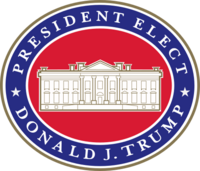President-elect of the United States facts for kids
Quick facts for kids President-elect of theUnited States of America |
|
|---|---|
| Style | The Honorable |
| Term length | In the period between the general election on Election Day in November and Noon (Eastern Standard Time) on Inauguration Day
Between the Election and Inauguration
|
| Inaugural holder | George Washington January 10, 1789 |
| Formation | No official formation |
| Deputy | Vice President-elect of the United States |
| Salary | None |
The president-elect of the United States is the person who has won the United States presidential election. They are waiting to officially become the President. The U.S. Constitution doesn't say exactly when someone becomes "president-elect." However, the Twentieth Amendment uses the term. This means the term "president-elect" is part of the Constitution.
Most people agree that a candidate becomes the official "president-elect" after Congress confirms the votes. These votes come from the Electoral College. This usually happens after January 3rd, following the new Congress starting. The media has used the term "president-elect" since the late 1800s. Politicians have used it even longer, since the 1790s. People often call the expected winner "president-elect" on election night.
Election Day is in early November. But the Electoral College members don't officially vote until mid-December. The presidential inauguration, where the new president takes the oath of office, is usually on January 20th. The Constitution only says that the winner must be ready to take the oath.
The Presidential Transition Act of 1963 helps the government prepare for a new president. It allows the General Services Administration (GSA) to decide who the likely winner is. This law helps the "president-elect's transition" team get ready. It also provides office space for them. During the time between the election and the inauguration, the president-elect gets ready for their new job. They work with the outgoing president to make sure everything runs smoothly. Since 2008, incoming presidents have called their preparation group the Office of the President-Elect.
A president who wins re-election is not called "president-elect." This is because they are already in office. A vice president who is elected president is called "president-elect."
Contents
History of the Term "President-Elect"
The term "president-elect" has been used for a long time. It goes back to at least the 1790s. Some of the Founding Fathers of the United States used it in letters about the 1796 United States presidential election. These letters show that people used the term for candidates who seemed to have won. This happened even before all the votes were known.
Big news companies started using the term regularly in the late 1800s. In 1933, the Twentieth Amendment to the United States Constitution was approved. This made the term "president-elect" an official part of the Constitution of the United States.
How U.S. Presidential Elections Work
The rules for electing the U.S. president are in the United States Constitution. They are mainly in Article II, Section 1, Clause 2 and the Twelfth and Twentieth Amendments. Other federal and state laws also help manage the process.
The Electoral College's Role
In the U.S., people don't directly vote for the president. Instead, they vote for a group of people called electors. These electors then form the Electoral College. They are the ones who actually vote for the president.
- Election Day: On the first Tuesday after the first Monday in November, every four years, people vote. This vote helps choose the electors for each state.
- Electors Vote: In mid-December, the electors meet in their state capitals. They cast their votes for president and vice president.
- Votes Sent to Congress: After voting, the electors send their official vote counts to the president of the U.S. Senate.
- Congress Counts Votes: In early January, both houses of Congress meet together. They officially count the electoral votes.
- Winner Declared: To win, a candidate needs at least 270 electoral votes. The current Vice President, who leads the Senate, announces the winner.
- No Clear Winner: If no candidate gets 270 votes, the House of Representatives chooses the president. The Senate chooses the vice president.
Even though electors are chosen by popular vote, the Constitution does not force them to vote for the winner of their state's popular vote. However, some states have laws that require electors to vote as promised. The Supreme Court has said these laws are constitutional. Very few electors have ever voted differently than pledged. These "faithless electors" have never changed the election outcome.
When Does Someone Become President-Elect?
Experts have different ideas about when someone officially becomes "president-elect."
- Some think it's only after Congress counts and announces the electoral votes in January.
- Others believe it happens as soon as a candidate gets a majority of electoral votes. This is true even if the votes haven't been officially counted yet.
A report from the U.S. House of Representatives in 1933 supported the second idea. It said that a person becomes president-elect as soon as the electoral votes are cast. This is true even if the votes haven't been counted yet.
What if the President-Elect Can't Serve?
What happens if a president-elect dies or can't take office?
- Before Electoral College Votes: If the winner dies before the electors vote in December, their political party would choose a new candidate. The electors would then vote for that new person. The vice president candidate would become president-elect.
- After Electoral College Votes, Before Congress Counts: If the winner dies after the electors vote but before Congress counts them, the votes for the deceased candidate would still be counted. Congress would declare that person won.
- On Inauguration Day: The Twentieth Amendment (ratified in 1933) deals with this. If the president-elect dies before noon on January 20th (Inauguration Day), the vice president-elect becomes president. If there is no president-elect or vice president-elect, Congress decides who will be the acting president. The Presidential Succession Act of 1947 then lists who would take over, starting with the Speaker of the House.
Only one presidential candidate, Horace Greeley, won electoral votes and then died before the inauguration. This happened in 1872. He had already lost the election, so his death didn't change the outcome.
There have been a few close calls:
- In 1853, President-elect Franklin Pierce survived a train crash that killed his son.
- In 1857, President-elect James Buchanan got very sick before his inauguration.
- In 1933, President-elect Franklin D. Roosevelt survived an assassination attempt. If he had died, his vice president-elect, John Nance Garner, would have become president.
Presidential Transitions
Since the mid-1800s, it's usually clear who has won the election very quickly. This gives the incoming president valuable time to prepare.
Recent presidents-elect create special teams to help with the transfer of power. Outgoing presidents work with the president-elect to ensure a smooth change. This helps keep important government operations running without problems. Before 1933, the new president didn't take office until March. This was four months after the election. The Twentieth Amendment changed this to January 20th.
The Presidential Transition Act of 1963 gives the president-elect certain benefits. These include office space, communication services, and staff. This helps them get ready for their new job. However, the Act does not give the president-elect any official powers. It also doesn't officially create an "Office of the President-Elect."
Despite this, presidents-elect like Barack Obama and Donald Trump have used the name "Office of the President-Elect." They used it on their websites and during speeches.
The GSA can send a "letter of ascertainment" to the apparent winners. This happens even before the Electoral College votes in December. This letter allows the president-elect and their team to get federal funding and services. There are no strict rules for how the GSA decides who the winner is. Usually, the GSA chief makes the decision after news organizations declare a winner. Or it happens after the losing candidate admits defeat.
On Inauguration Day, the new president takes an oath. They promise to "faithfully execute the Office of President" and "preserve, protect and defend the Constitution." The Twentieth Amendment says that a presidential term ends and begins at noon on January 20th. There's a small mystery about who is president during the few minutes between noon and when the new president takes the oath. Some think the president-elect isn't president until they take the oath. Others think they become president at noon, and the oath is just a ceremony.
The president-elect and vice president-elect get protection from the United States Secret Service. Major party candidates also get this protection during the election campaign.
List of Presidents-Elect
See also
 In Spanish: Presidencia electa de los Estados Unidos para niños
In Spanish: Presidencia electa de los Estados Unidos para niños




